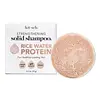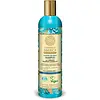What's inside
What's inside
 Key Ingredients
Key Ingredients

No key ingredients
 Benefits
Benefits

 Concerns
Concerns

 Ingredients Side-by-side
Ingredients Side-by-side

Water
Skin ConditioningSodium Coco-Sulfate
CleansingLauryl Glucoside
CleansingCocamidopropyl Betaine
CleansingSodium Chloride
MaskingPanthenol
Skin ConditioningHippophae Rhamnoides Fruit Water
SolventPhospholipids
Skin ConditioningGlycine Soja Oil
EmollientHippophae Rhamnoidesamidopropyl Betaine
CleansingHippophae Rhamnoides Fruit Oil
Skin ProtectingPineamidopropyl Betaine
CleansingArgania Spinosa Kernel Oil
EmollientLinum Usitatissimum Seed Oil
PerfumingGuar Hydroxypropyltrimonium Chloride
Skin ConditioningAbies Sibirica Needle Extract
PerfumingFlavocetraria Nivalis Extract
HumectantRhodiola Rosea Root Extract
EmollientPinus Sibirica Needle Extract
HumectantRosa Damascena Flower Water
MaskingRubus Arcticus Fruit Extract
AntioxidantBiotin/Folic Acid/Cyanocobalamin/Niacinamide/Pantothenic Acid/Pyridoxine/Riboflavin/Thiamine/Yeast Polypeptides
Skin ConditioningSodium PCA
HumectantSodium Lactate
BufferingArginine
MaskingAspartic Acid
MaskingPCA
HumectantGlycine
BufferingAlanine
MaskingSerine
MaskingValine
MaskingProline
Skin ConditioningThreonine
Isoleucine
Skin ConditioningHistidine
HumectantPhenylalanine
MaskingHydrolyzed Wheat Protein
Skin ConditioningCitric Acid
BufferingBenzyl Alcohol
PerfumingDehydroacetic Acid
PreservativeSodium Benzoate
MaskingPotassium Sorbate
PreservativeParfum
MaskingCI 15985
Cosmetic ColorantCI 16255
Cosmetic ColorantCI 19140
Cosmetic ColorantWater, Sodium Coco-Sulfate, Lauryl Glucoside, Cocamidopropyl Betaine, Sodium Chloride, Panthenol, Hippophae Rhamnoides Fruit Water, Phospholipids, Glycine Soja Oil, Hippophae Rhamnoidesamidopropyl Betaine, Hippophae Rhamnoides Fruit Oil, Pineamidopropyl Betaine, Argania Spinosa Kernel Oil, Linum Usitatissimum Seed Oil, Guar Hydroxypropyltrimonium Chloride, Abies Sibirica Needle Extract, Flavocetraria Nivalis Extract, Rhodiola Rosea Root Extract, Pinus Sibirica Needle Extract, Rosa Damascena Flower Water, Rubus Arcticus Fruit Extract, Biotin/Folic Acid/Cyanocobalamin/Niacinamide/Pantothenic Acid/Pyridoxine/Riboflavin/Thiamine/Yeast Polypeptides, Sodium PCA, Sodium Lactate, Arginine, Aspartic Acid, PCA, Glycine, Alanine, Serine, Valine, Proline, Threonine, Isoleucine, Histidine, Phenylalanine, Hydrolyzed Wheat Protein, Citric Acid, Benzyl Alcohol, Dehydroacetic Acid, Sodium Benzoate, Potassium Sorbate, Parfum, CI 15985, CI 16255, CI 19140
Ingredients Explained
These ingredients are found in both products.
Ingredients higher up in an ingredient list are typically present in a larger amount.
This ingredient is derived from guar gum.
It is a conditioning ingredient, meaning it helps soften skin and hair.
Parfum is a catch-all term for an ingredient or more that is used to give a scent to products.
Also called "fragrance", this ingredient can be a blend of hundreds of chemicals or plant oils. This means every product with "fragrance" or "parfum" in the ingredients list is a different mixture.
For instance, Habanolide is a proprietary trade name for a specific aroma chemical. When used as a fragrance ingredient in cosmetics, most aroma chemicals fall under the broad labeling category of “FRAGRANCE” or “PARFUM” according to EU and US regulations.
The term 'parfum' or 'fragrance' is not regulated in many countries. In many cases, it is up to the brand to define this term.
For instance, many brands choose to label themselves as "fragrance-free" because they are not using synthetic fragrances. However, their products may still contain ingredients such as essential oils that are considered a fragrance by INCI standards.
One example is Calendula flower extract. Calendula is an essential oil that still imparts a scent or 'fragrance'.
Depending on the blend, the ingredients in the mixture can cause allergies and sensitivities on the skin. Some ingredients that are known EU allergens include linalool and citronellol.
Parfum can also be used to mask or cover an unpleasant scent.
The bottom line is: not all fragrances/parfum/ingredients are created equally. If you are worried about fragrances, we recommend taking a closer look at an ingredient. And of course, we always recommend speaking with a professional.
Learn more about Parfum